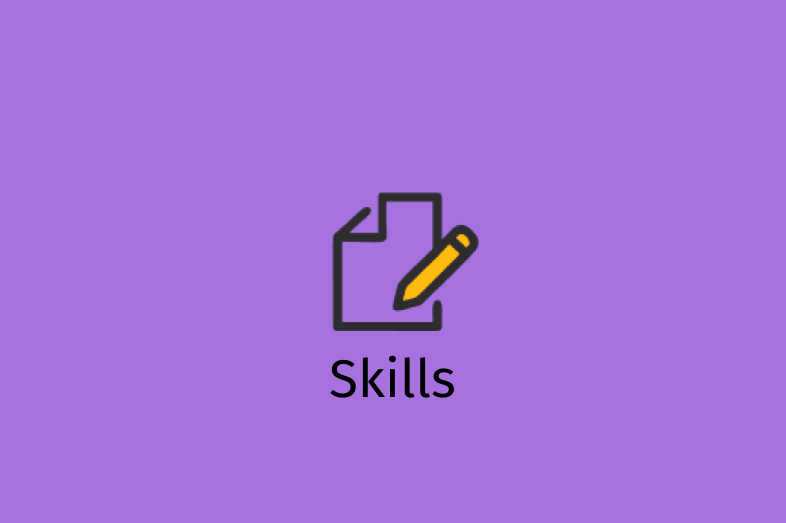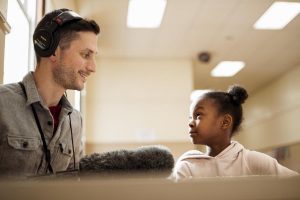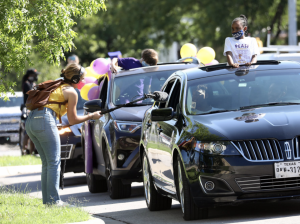
Covering Protests: Education Journalists’ Voices From the Field
‘The protest stories are education stories’

‘The protest stories are education stories’
Across the country, education reporters are out in the field covering community protests mounted in response to police brutality and the death of George Floyd, a black man who died after a Minneapolis police officer knelt on his neck for nearly nine minutes.
I reached out to some of the reporters covering the protests to glean tips for keeping safe, and how these events are poised to influence education reporting. (Take a look at EWA’s overview of expert recommendations on covering protests and police.)
As longtime beat reporter Adolfo Guzman-Lopez of KPCC-Southern California Public Radio told me, the protest stories are education stories. Guzman-Lopez, who is recovering after being struck in the throat by a rubber bullet while covering a protest May 31, said he noticed how many of the participants appeared to be in their 20s and 30s. What was the quality of their high school experience? Did they have trouble finding jobs after graduation? How many of them went to college and were politicized or mobilized by participating in an ethnic studies program?
Those are the nuanced questions that come after “Why are you out here at the intersection of Third and Pine in Long Beach?” Guzman-Lopez said.
Here’s what some of our other EWA journalist members had to say, drawn from telephone conversations and email exchanges. (Education writer Alexander Russo of The Grade also provided a roundup of advice and interviews with journalists.) Their comments have been lightly edited for clarity and length.
Today, I covered the protests. Tonight, I was arrested for walking to my car past curfew. (Despite having a press exemption and wearing my press pass prominently.) I am ok. More soon. pic.twitter.com/Mt5phZ8ck7
— Kristen Graham (@newskag) June 2, 2020
Kristen Graham, a Pulitzer Prize winner who is on the urban public schools beat for The Philadelphia Inquirer, was tear gassed and then arrested June 1 while covering a protest.
I volunteered to cover the protests because I feel strongly that the response to George Floyd’s death and the demonstrations for racial justice are a defining moment. As a journalist, I feel compelled to help document that. … What stood out most for me was the energy of the crowd — angry, anguished, but resolved.
I went into coverage with my eyes wide open. I was not afraid for my safety until the crowd I walked with, several thousand strong, began clambering down onto Vine Street Expressway, a major interstate in Philadelphia. Soon after the leading edge headed that way, I saw and then felt tear gas fired. Certainly then I was afraid for my safety and for the safety of those around me. What surprised me most was the complete lack of regard the officers who arrested me had for the city’s own rules regarding curfew and who should be detained. Also, I was surprised at the blatant disparities in how the curfew was enforced, and who got arrested.
One particular moment that I keep flashing back to — a lot — in the days since my arrest is what it felt like as the bus I was riding in pulled away from City Hall, where I was arrested. The people around me were all handcuffed, but chanting, “No good cops in a racist system.” We were all hot and exhausted. Most of us had just walked miles. I had to use the bathroom. I had no idea how I would get word to my editor or my husband that I had been detained, and I knew both would start worrying imminently. The grill separating us and the police officers was closed, but an officer in the front was smoking a cigarette, and the smell was making me feel sick. It was completely surreal.
My arrest absolutely will impact my education coverage going forward, and my work as a journalist in general. My ordeal was extremely unpleasant, but even as the officers were fitting cuffs around my wrists, I kept telling myself, “You’re going to be ok.” I am a cisgender white woman with a network and resources that pretty much guaranteed my ultimate safety. Many of the women on the bus with me didn’t have those same guarantees, and that’s also the case with many of the kids and families who attend the schools I cover. I can’t imagine the fear or the injustices inherent in being black or brown, but I got a glimpse of a fraction of what black and brown folks risk just by walking out the door every day. That will make me a better reporter.
In addition to the current protests, Ryan Delaney of St. Louis Public Radio covered protests in 2017 after a white police officer was acquitted of killing Anthony Lamar Smith, a black motorist involved in a high-speed chase.

(Courtesy of Ryan Delaney)
It’s been a lot to take in. For months, we’ve been trying to do our jobs the best we can while holed up in our homes, only talking to people over the phone and Zoom. It was a bummer because the best part of education journalism is being in classrooms and talking to kids.
Suddenly, as these protests break out, we’re being sent out and not just to arranged interviews, but large gatherings of people packed onto the streets. It’s jarring and a little unnerving to add the public health risks on top of the other safety risks of covering demonstrations. My colleagues and I are trying to figure that out while keeping ourselves and our families safe.
I’ll say that once it gets dark, typically it gets much harder to conduct interviews, so do those early. Try to take notes and mark the time over the course of the evening, even if it’s just what you’re seeing and hearing. It’ll all meld together, and you’ll be tired at 1 a.m. when you’re writing your story. Also, it’s hard to confirm a lot in the moment, such as [if police are using] pepper spray versus tear gas. A lot will get shouted by protesters, but that’s not always accurate.
Being out at night during these combative, heated protests is stressful, dangerous and can be emotionally draining. It’s hard to come down from the adrenaline and fear at the end of the night, even if you’re physically tired. Make sure you take care of yourself: Hug a loved one, pet a dog, do deep breathing. Try to avoid staying up even later and drinking alcohol. Two or three weeks of sustained nighttime coverage can disrupt your sleep schedule and personal life and health. Be aware of it. Hopefully, editors are aware of it, but if you’re feeling drained, tell your editor and advocate for time off.
Some of the scenes from Saturday night in Ferguson, as hours of peaceful #GeorgeFloydProtests turned destructive. pic.twitter.com/7u0S3ykLyH
— Ryan P. Delaney (@rpatrickdelaney) May 31, 2020
Education reporter Olivia Krauth of the Louisville Courier Journal joined her newsroom colleagues in covering the protests throughout that city. She’s also reported on the aftermath of the death of Breonna Taylor, a 26-year-old unarmed black woman who was killed in her home by Louisville police in the middle of the night.

(Courtesy of Olivia Krauth)
After the first night of protests in Louisville on Thursday, I volunteered to go out to report on them. The issues of systemic racial injustice and police brutality impact the lives of the students I cover. Often, those students are leading the work to fix those issues.
Watching hundreds of people protest is powerful. As it grew heated, it became a little terrifying. Anger now sounds like a water bottle repeatedly slamming against the glass panes of Louisville’s Hall of Justice, trying to shatter the glass, mixing with the smell of spray paint as people graffitied the building. That stands out most in my recollection of the weekend.
Also, tear gas. That for sure stands out. Naive me was standing relatively close when police fired the first round of tear gas Friday night. I hadn’t experienced it before. I saw the plume of smoke and ran, but my instinct to tweet was stronger than my instinct to be able to breathe (very on brand for me). I stopped and stood to get tweets out and got hit pretty bad. It built under my glasses and caught in my mask, ultimately resulting in me collapsing in a patch of grass near a coworker who was in the same situation.
I never feared for my safety, which is odd, because I’m often the anxious one. I feared more that my phone would die, honestly. I quickly became numb to the terror, running from loud noises because they were loud and not because I feared getting hurt. The lack of fear is largely built out of my privilege: I’m a white woman in a press vest.
Honestly, the most surprising element was how the police reacted. Protesters were protesting police force, and often, police seemed to respond with force. Peaceful protests would get tear gassed before curfew, and officials would say they saw leaf blowers in the crowd. Or protesters’ stashes of water and milk would be confiscated or destroyed, and officials would say, without proof, there were flammable materials in the stash. My confusion burned to anger; I felt like I wasn’t getting the full story, which made me feel as if I wasn’t doing my job of holding officials accountable. Then law enforcement shot and killed a black man early Monday morning while enforcing a protest-sparked curfew, and that was stunning. It felt like one thing after another after another, after Louisville’s black community has been disadvantaged for decades.
Being a journalist in this moment — covering a protest of national importance in the middle of a pandemic during a presidential election year — is exactly why I’m in the profession. I’ve never felt like I was truly writing the first draft of history until this year, and now holding government officials and institutions accountable is absolutely critical to society.
Advice for education reporters: Use your skills spotlighting youth voices to keep amplifying youth voices. So many of the protesters are high school or college age. Seek them out, especially those of color. Also, do your homework. Most education reporters cover race on the beat, but keep reading and be aware of implicit biases and privilege.
The protest is moving through one of the tree-lined streets off Bardstown.
The area is relatively white and wealthy. Homeowners are coming outside, a few with fists in the air in support. pic.twitter.com/m3vMp89BMv
— Olivia Krauth (@oliviakrauth) May 31, 2020
Reporting for KUT in Austin, Texas, Claire McInerny said she’s focusing on improving her own understanding of the underlying issues driving the protests, and making sure her coverage is responsible. “This moment isn’t new for many people, and that’s what I heard from black folks. They are tired of having the same conversation over and over and feeling like they are not respected by our government and society.”

(Courtesy of Claire McInerny)
As a human being, it’s awful to watch our country go through this. But as a journalist In this particular moment, and as a white woman, I’m doing a lot of reading and talking to people to make sure that I am reporting in a way that honors the cause of these protests and providing enough context. I don’t have the lived experience of black people so I’m trying to do work to not let my blind spots cause harm in my writing.
Besides taking care of logistical needs, I spent the morning finding tips about writing and especially tweeting on the fly. I made sure to have a note on my phone with the correct spellings of the [names of the] most recent people killed by police and links to stories we wrote so I could tweet that context. I never write about police, so a lot of terms were new to me — for example I was tweeting ‘non-lethal rounds’ when talking about bean bag rounds, but I should say ‘less-lethal,’ in quotes, because that ammo can seriously injure people and absolutely kill them. We saw people in Austin put in critical condition with this ammo. I would have bought goggles to protect from pepper spray. After the first day, our newsroom ordered some from Home Depot.
It’s important to remember that even though it’s exhausting and intense to cover this, it’s also very valid that many black people and people of color are frustrated with the news media. We won’t be celebrated by everyone, and that’s fair. It’s easy to follow the sensational acts — following a group of protesters as they try and shut the highway down and leaving those who stay behind to continue peacefully demonstrating.
Black journalists on Twitter are sharing a ton of criticism, which our white-dominant industry needs. There are ways we have been writing, tweeting, covering our communities that don’t center the issues. So we should all be absorbing that. I also think it’s important to remember when we are not always worthy of being the story. There are so many selfies of journalists posting photos after being tear gassed — which sucks — but would it be better to find a protester who was also in that crowd and ask for their story? We’re out there to report on others, not ourselves.
David Jesse of the Detroit Free Press — who won the top prize for beat reporting in the 2019 EWA Awards — has covered multiple protests over the course of his long career. He was sprayed with tear gas at a protest in Detroit on May 31.

(Courtesy of David Jesse)
The only time I was really afraid for my safety was towards the end of the night, when police approached a group of Free Press journalists and a few non-journalists. One walked over and pointed a rubber-bullet gun at us. The cops threw tear gas right at us, and as we were running away, started shooting rubber bullets at us. One hit one of the non-journalists standing behind us. Another hit at the feet of one of the photographers. I spent most of the night traveling with Branden Hunter, a 20-something African-American man and Free Press reporter. Several times, cops would run past me (a middle-aged white man) and right at him, screaming at him, even as we both were displaying the same credentials and yelling we were media. I was afraid the police were going to do something to him. I never felt the protesters were targeting us in any way.
This is the moment of our time – the biggest story of my 20-year career in journalism. It’s so important to be there to document everything that’s going on – the police that are kneeling with protesters and the police that are shooting at journalists and bystanders; the protesters that are in deep anguish over a system that has failed them multiple time and the protesters who are just looking for an excuse to break into the Nike store. Fall back on the basics of reporting. Describe the scene to those following you on Twitter. We’re used to talking to younger people. Use those skills to draw stories out. Watch out for your teammates – we traveled in packs of at least two and sometimes more for safety. Protect yourself. Give yourself time after coverage to emotionally recover. I still tense up watching the tear gas fly and can feel the tension inside a couple days after being out there. Tell the full story.
Your post will be on the website shortly.
We will get back to you shortly